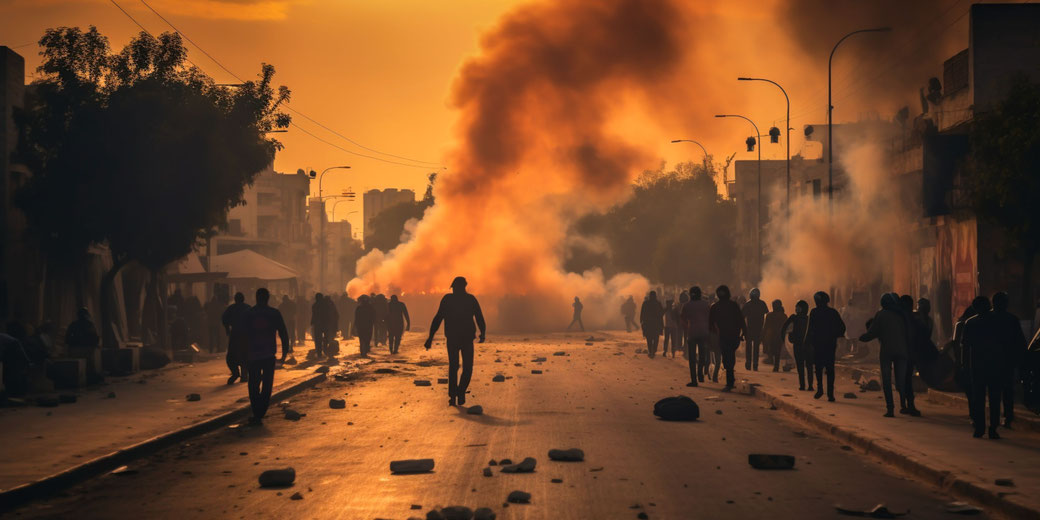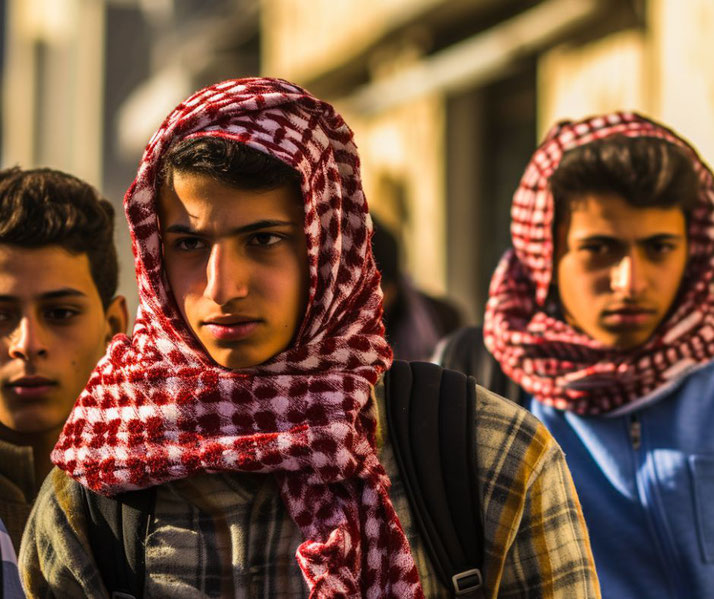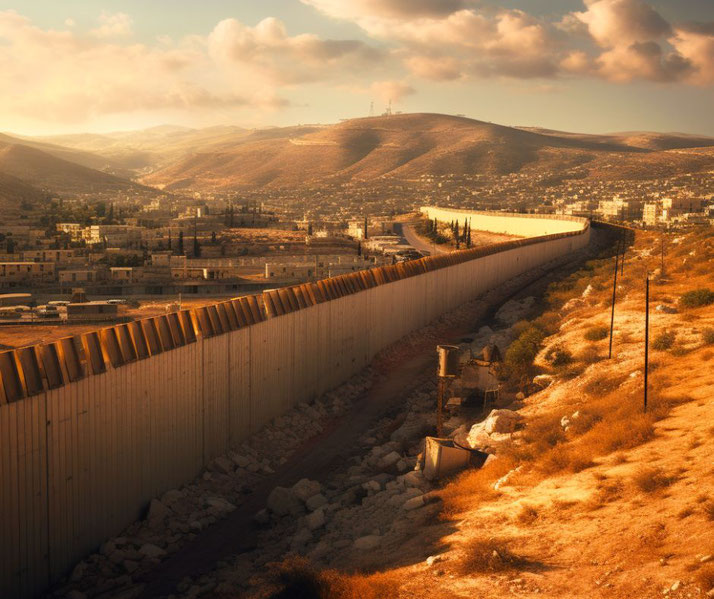Understanding the intifadas and Palestinian resistance

The Israeli-Palestinian conflict, spanning over a century, has witnessed moments of hope, despair, upheaval, and tentative peace.
Among its many chapters, the First and Second Intifadas emerge as pivotal uprisings that not only shook the region but also captured global attention. Intifada is an Arabic word meaning uprising.
But what drove the Palestinian populace to rise not once, but twice, against a formidable military power?
How did these uprisings shape the course of negotiations and the quest for a two-state solution?
Historical context of the intifadas
The Israeli-Palestinian conflict's roots trace back to the late 19th and early 20th centuries when nationalist movements emerged among various ethnic and religious groups in the Ottoman Empire.
The Zionist movement, advocating for a Jewish homeland in Palestine, gained momentum during this period.
The Balfour Declaration of 1917, issued by the British government, expressed support for the establishment of a "national home for the Jewish people" in Palestine.
This was followed by increased Jewish immigration to the region.
By the time the British Mandate for Palestine ended in 1948, tensions between Jewish and Arab communities had reached a boiling point.
The United Nations proposed a partition plan in 1947, which would divide Palestine into separate Jewish and Arab states.
While Jewish leaders accepted the plan, Arab leaders did not. This led to the 1948 Arab-Israeli War, following which Israel declared its independence.
The war concluded with armistice agreements in 1949, but not before leading to significant demographic changes, including the displacement of a large number of Palestinian Arabs.
The subsequent decades saw a series of wars and skirmishes, notably the Six-Day War in 1967, during which Israel captured the West Bank, Gaza Strip, East Jerusalem, Sinai Peninsula, and the Golan Heights.
The occupation of these territories intensified Palestinian nationalistic sentiments and resistance movements.
By the 1980s, Palestinian frustrations with the ongoing occupation, coupled with socio-economic hardships and perceived negligence by the Arab world, set the stage for widespread unrest.
First Intifada (1987-1993)
The First Intifada, which began in December 1987, was a spontaneous uprising that emerged from the collective frustrations of Palestinians living under Israeli occupation.
It started in the Jabalia refugee camp in the Gaza Strip following a traffic accident in which an Israeli truck collided with a Palestinian vehicle, resulting in the deaths of four Palestinians.
While the incident itself might have been accidental, it ignited the already volatile atmosphere, leading to widespread protests, demonstrations, and clashes with Israeli forces.
Unlike previous resistance movements, the First Intifada was characterized by its grassroots nature, with local committees and groups taking the lead rather than established political factions.
The uprising saw a mix of civil disobedience, general strikes, boycotts of Israeli products, and the establishment of underground schools, as Israel had closed Palestinian educational institutions.
Stone-throwing by Palestinian youths became a symbolic act of defiance against heavily armed Israeli forces.
Israel responded with a combination of military and administrative measures. The then Israeli Defense Minister, Yitzhak Rabin, adopted an 'iron fist' policy, which involved mass arrests, curfews, house demolitions, and deportations.
The use of live ammunition against protesters led to significant casualties on the Palestinian side.
As the Intifada progressed, the Palestine Liberation Organization (PLO), led by Yasser Arafat, sought to capitalize on the momentum.
The PLO's political maneuvering on the international stage, combined with the visible resistance on the ground, pressured Israel to reconsider its stance on negotiations.
The First Intifada cost the Palestinian economy an estimated $650 million in lost income due to widespread curfews, closures, and trade disruptions imposed by Israeli authorities.

Oslo Accords and Interim Period
Between 1993 and 2000, the number of Israeli settlers in the West Bank nearly doubled, increasing from approximately 110,000 to over 200,000.
At the same time, the Oslo Accords, a series of agreements between Israel and the PLO, represented a significant shift in the Israeli-Palestinian conflict.
Initiated in secret meetings in Norway, the negotiations culminated in the signing of the Oslo I Accord on September 13, 1993, on the White House lawn.
With a historic handshake between Yasser Arafat, the PLO chairman, and Yitzhak Rabin, the Israeli Prime Minister, the world witnessed what many hoped would be the dawn of a new era of peace.
The accords established a framework for the Palestinian self-rule in the West Bank and Gaza Strip over a five-year interim period.
The Palestinian Authority (PA) was created to oversee the administration of areas from which Israel would gradually withdraw.
The city of Jericho and the Gaza Strip saw the first of these withdrawals in 1994.
The Oslo II Accord, signed in 1995, divided the West Bank into Areas A, B, and C.
Area A was under Palestinian Authority control, Area B under joint control, and Area C under Israeli control.
However, the interim period was far from smooth. While the accords did lead to some positive developments, including the establishment of the Palestinian Authority and the withdrawal of Israeli forces from certain areas, they also faced significant challenges.
The agreements were met with opposition from factions on both sides. Palestinian groups like Hamas and Islamic Jihad, viewing the accords as a betrayal of the Palestinian cause, carried out suicide bombings in Israel.
On the Israeli side, right-wing groups opposed territorial concessions, culminating in the assassination of Prime Minister Rabin by a Jewish extremist in 1995.
Economic hardships, continued Israeli settlement expansion, and the lack of a clear path to a final-status solution further strained the situation.
The promised final-status negotiations, meant to address core issues like Jerusalem, refugees, borders, and settlements, faced repeated delays.
Second Intifada (2000-2005)
The Second Intifada, also known as the Al-Aqsa Intifada, erupted in September 2000 and was markedly different in character and intensity from its predecessor.
The immediate spark was the visit of Ariel Sharon, the leader of Israel's opposition at the time, to the Temple Mount or Haram al-Sharif in Jerusalem, a site revered by both Jews and Muslims.
While Sharon described his visit as a peaceful gesture, Palestinians perceived it as a provocative act.
The subsequent violent confrontations between Palestinian protesters and Israeli police rapidly escalated into a full-blown uprising.
This Intifada was characterized by a series of violent events, including suicide bombings targeting Israeli civilians, and a robust military response from Israel.
Palestinian militant groups, notably Hamas and Islamic Jihad, carried out numerous attacks inside Israel, causing significant civilian casualties.
In response, Israel launched military operations in the West Bank and Gaza Strip, targeting militants, but also causing substantial Palestinian civilian casualties and infrastructure damage.
One of the most significant Israeli countermeasures during this period was the construction of the West Bank barrier, a combination of fences and walls.
Israel argued that the barrier was essential for security reasons, to prevent militants from entering Israel.
However, Palestinians contended that its route, which often deviated from the Green Line, was an attempt to annex Palestinian land and disrupt the territorial continuity of a future Palestinian state.
In fact, the International Court of Justice deemed the barrier a violation of international law in its advisory opinion (2004).

Internationally, the violence and its implications were of grave concern. Efforts to mediate and bring an end to the hostilities were numerous.
The Quartet on the Middle East, comprising the United States, Russia, the European Union, and the United Nations, proposed the Roadmap for Peace in 2003, envisioning a two-state solution.
However, mutual distrust, ongoing violence, and political complexities hindered significant progress.
By 2005, the violence had decreased, partly due to unilateral actions like Israel's disengagement from the Gaza Strip.
However, the deep scars and mistrust left by the Second Intifada continued to influence Israeli-Palestinian relations.
The Second Intifada resulted in the deaths of approximately 3,000 Palestinians and 1,000 Israelis, with a significant number of civilians affected on both sides.
On-going tensions and consequences
For Palestinians, the First Intifada was a moment of empowerment. The grassroots nature of the uprising showcased a collective will to resist occupation and assert national identity.
It brought the Palestinian cause to the forefront of international attention and paved the way for diplomatic engagements, most notably the Oslo Accords.
However, the Second Intifada, with its heightened violence, also revealed the deep divisions within Palestinian society.
The rise of groups like Hamas challenged the dominance of the PLO and Fatah, leading to political fragmentation.
The economic toll of the uprisings was severe, with closures, curfews, and military operations stifling economic activity and causing widespread hardship.
On the Israeli side, the Intifadas led to a reevaluation of security and political strategies.
The First Intifada exposed the challenges of maintaining control over a restive civilian population and underscored the need for a political solution.
The Second Intifada, with its wave of suicide bombings, instilled a sense of vulnerability among Israelis and influenced public opinion towards more stringent security measures, exemplified by the construction of the West Bank barrier.
The violence also led to a decline in the Israeli peace camp, with many perceiving the Oslo process as a failed experiment.
In retrospect, the Intifadas were more than just episodes of conflict; they were transformative periods that reshaped political landscapes, altered strategic calculations, and left lasting imprints on generations of Israelis and Palestinians.
The challenges and lessons from these uprisings continue to inform the quest for a just and lasting peace in the region.
What do you need help with?
Download ready-to-use digital learning resources
Copyright © History Skills 2014-2025.
Contact via email
With the exception of links to external sites, some historical sources and extracts from specific publications, all content on this website is copyrighted by History Skills. This content may not be copied, republished or redistributed without written permission from the website creator. Please use the Contact page to obtain relevant permission.





